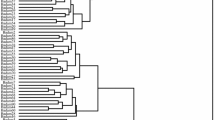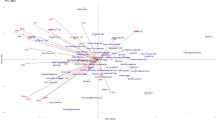Abstract
A pool of 158 Triticum monococcum L. ssp. monococcum accessions, originating from different traditional cropping areas and representative of the einkorn germplasm collection maintained at Sant’Angelo Lodigiano, was characterised for 20 morpho-physiological and qualitative descriptors. The accessions were grown for 4 years in two different Po plain (Italy) locations. The traits analysed were growth habit, awn length, glume colour and hairiness, rachis brittleness, heading date, plant height, spike length, n° spikelets/spike, spikelet density, n° kernels/spikelet, kernel length, width, thickness and volume, thousand kernels weight, protein and carotenoid content, sodium dodecyl sulphate sedimentation volume and specific sedimentation volume. A broad variation for all the traits studied was detected and promising accessions for breeding purposes were identified. Several characteristics showed a clear region-specific pattern: the samples tracing their origin to warmer climates were earlier-maturing, taller, had shorter spikes, fewer spikelet/spike, bigger kernels and lower protein content than those from cooler regions. A Principal Components Analysis highlighted the existence of two clusters composed mainly of Maghreb/Iberia and of Prealpine genotypes, whose peculiar characteristics are most likely a consequence of adaptation, by natural selection or by human practices and ingenuity, to their growing environments.





Similar content being viewed by others
Change history
09 April 2020
The original version of this article was revised: In the original publication of the article, the word “symbol” was mistakenly added to the article title.
References
Abdel-Aal E-SM, Young JC, Wood PJ, Rabalski I, Hucl P, Falk D, Frégeau-Reid J (2002) Einkorn: a potential candidate for developing high lutein wheat. Cereal Chem 79:455–457
Brandolini A, Heun M (2019) Genetics of brittleness in wild, domesticated and feral einkorn wheat (Triticum monococcum L.) and the place of origin of feral einkorn. Genet Resour Crop Evol 66:429–439
Brandolini A, Hidalgo A, Moscaritolo S (2008) Chemical composition and pasting properties of einkorn (Triticum monococcum L. subsp. monococcum) whole meal flour. J Cereal Sci 47:599–609
Brandolini A, Volante A, Heun M (2016) Geographic differentiation of domesticated einkorn wheat and possible Neolithic migration routes. Heredity 117:135–141
Corbellini M, Empilli S, Vaccino P, Brandolini A, Borghi B, Heun M, Salamini F (1999) Einkorn (Triticum monococcum) characterization for bread and biscuit production in relation to protein subunit composition. Cereal Chem 76:727–733
Dinu M, Whittaker A, Pagliai G, Benedettelli S, Sofi F (2018) Ancient wheat species and human health: biochemical and clinical implications. J Nutr Biochem 52:1–9
Empilli S, Castagna R, Brandolini A (2000) Morpho-agronomic variability of the diploid wheat Triticum monococcum L. Plant Genet Resour Newsl 124:36–40
Hammer Ø, Harper DAT, Ryan PD (2001) PAST: paleontological statistics software package for education and data analysis. Palaeontol Electron 4(1):9
Heun M, Schäfer-Pregl R, Klawan D, Castagna R, Accerbi M, Borghi B et al (1997) Site of einkorn wheat domestication identified by DNA fingerprinting. Science 278:1312–1314
Heun M, Haldorsen S, Vollan K (2008) Reassessing domestication events in the Near East: einkorn and Triticum urartu. Genome 51:444–451
Hidalgo A, Brandolini A (2008) Protein, ash, lutein and tocols distribution in einkorn (Triticum monococcum L. subsp. monococcum) seed fractions. Food Chem 107:444–448
Hidalgo A, Brandolini A (2019) Einkorn (Triticum monococcum) flour and bread. In: Preedy V, Watson R, Patel V (eds) Flour and breads and their fortification in health and disease prevention, 2nd edn. Academic Press, Elsevier Inc, New York, pp 99–110
Hidalgo A, Brandolini A, Pompei C, Piscozzi R (2006) Carotenoids and tocols of einkorn wheat (Triticum monococcum ssp. monococcum L.). J Cereal Sci 44:182–193
Lev-Yadun S, Gopher A, Abbo S (2000) The cradle of agriculture. Science 288:1602–1603
Nesbitt M, Samuel D (1996) From staple crop to extinction? The archaeologic and history of hulled wheats. In: Padulosi S, Hammer K, Heller J (eds) Hulled wheats. Promoting the conservation and use of underutilized and neglected crops. 4. Proceedings of the first international workshop on hulled wheats, 21–22 July 1995, Castelvecchio Pascoli, Tuscany, Italy. International Plant Genetic Resources Institute: Rome, pp 41–100
Oeggl K (2000) The diet of the Iceman. In: Bortenschlager S, Oeggl K (eds) The Iceman and his natural environment: palaeobotanical results. Springer, Wien-New York, pp 89–116
Perrino P, Laghetti G, D’Antuono LF, Al Ajlouni M, Kanbertay M, Szabó AT et al (1996) Ecogeographical distribution of hulled wheat species. In: Padulosi S, Hammer K, Heller J (eds) Hulled wheats. Promoting the conservation and use of underutilized and neglected crops. 4. Proceedings of the first international workshop on hulled wheats, 21–22 July 1995, Castelvecchio Pascoli, Tuscany, Italy. International Plant Genetic Resources Institute: Rome, pp 102–120
Preston KR, March PR, Tipples KH (1982) Assessment of the SDS sedimentation test for the prediction of Canadian bread wheat quality. Can J Plant Sci 62:545–553
Salamini F, Özkan H, Brandolini A, Schäfer-Pregl R, Martin W (2002) Genetics and geography of wild cereal domestication in the Near East. Nat Rev Genet 3:429–441
AACC International. Methods 14-60.01 and 46-10.01. In: Approved methods of analysis, 11th edn. AACC International Minneapolis, MN, USA. http://methods.aaccnet.org/toc.aspx
Acknowledgements
We acknowledge with gratitude the following donors: Dr. Leonor Peña-Chocarro, Consejo Superior de Investigaciones Cientificas, Madrid, Spain; Dr. Giuseppe Mariani, Istituto Sperimentale per la Cerealicoltura, Rome, Italy; Max Planck Institut, Cologne, Germany; Institut für Genetik und Kulturpflanzen Forschung, Gatersleben, Germany; Institut für Pflanzenbau und Pflanzenzüchtung, Braunschweig, Germany; Istituto di Genetica e Sperimentazione Agraria N. Strampelli, Lonigo, Italy; Istituto del Germoplasma, Bari, Italy; Istituto Nacional de Tecnologia Agropecuaria, Argentina; Vavilov All Union Institute of Plant Industry, Saint Petersburg, Russia; Institut Fédérale de Recherches Agronomiques, Nyon, Switzerland; Cambridge Laboratory, Norwich, England; Australian Winter Cereals Collection, Tamworth, Australia; University of Alberta, Edmonton, Canada; Kansas State University, Manhattan, Kansas, USA; National Small Grains Collection, Aberdeen, Idaho, USA.
Author information
Authors and Affiliations
Corresponding author
Ethics declarations
Conflict of interest
The authors declare that they have no conflict of interest.
Additional information
Publisher's Note
Springer Nature remains neutral with regard to jurisdictional claims in published maps and institutional affiliations.
The original version of this article was revised: In the original publication of the article, the word “symbol” was mistakenly added to the article title.
Electronic supplementary material
Below is the link to the electronic supplementary material.
10722_2020_923_MOESM3_ESM.docx
Online Resource 3. Score plot of the Principal Component Analysis carried out for the country of origin mean values of the 20 traits scored on the 158 Triticum monococcum analysed. (DOCX 36 kb)
Rights and permissions
About this article
Cite this article
Volante, A., Yilmaz, V.A., Hidalgo, A. et al. Morpho-physiological and qualitative variation of domesticated einkorn (Triticum monococcum L. ssp. monococcum). Genet Resour Crop Evol 67, 1493–1502 (2020). https://doi.org/10.1007/s10722-020-00923-6
Received:
Accepted:
Published:
Issue Date:
DOI: https://doi.org/10.1007/s10722-020-00923-6




